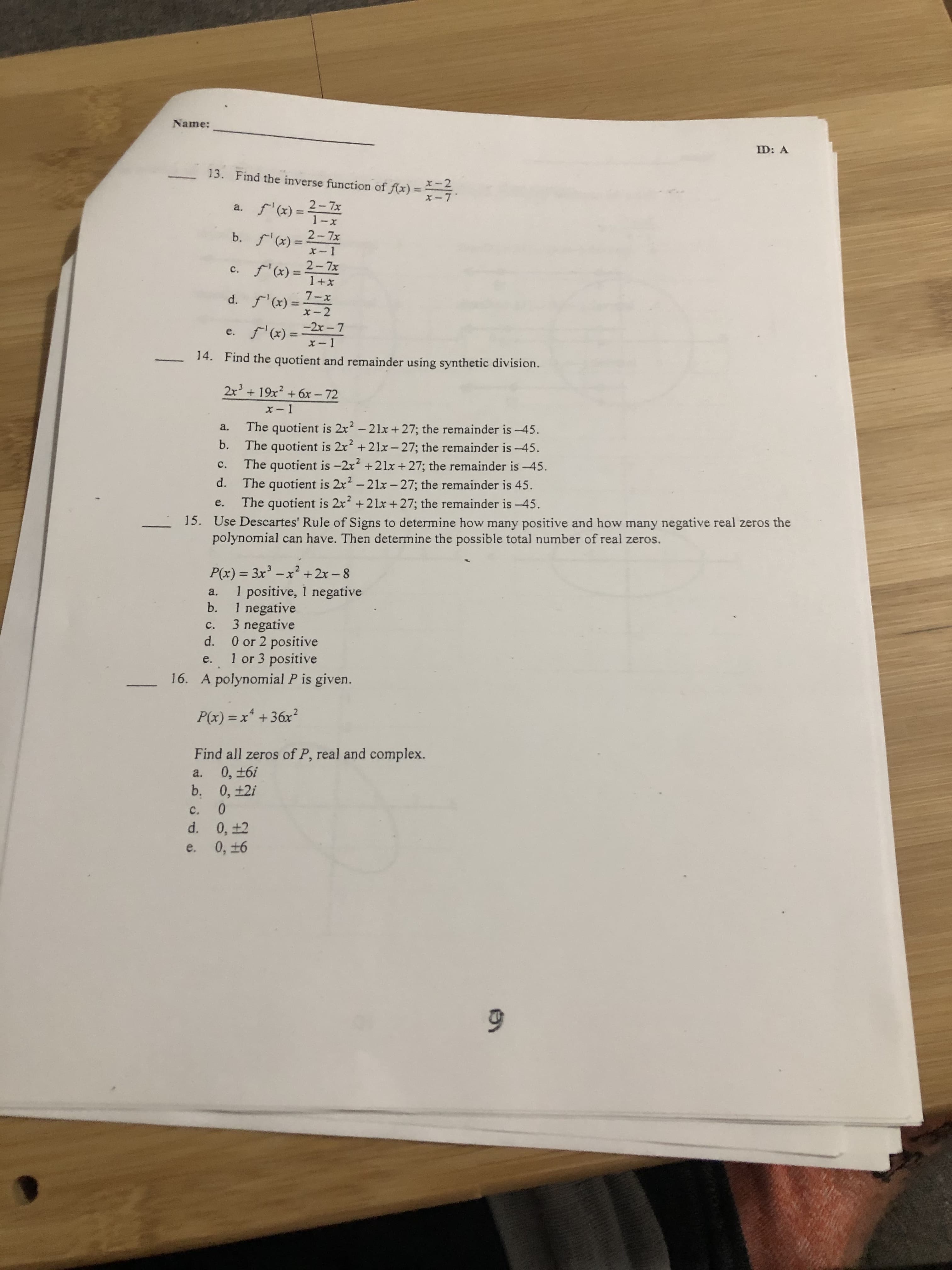Name: ID: A 13. Find the inverse function of f(x) 2-7x a. f'(x) = 2-7x b. f'(x) = c. f'(x) = 2-7x 7-x d. f'(x) = %3D e. f'(x) =-2x – 7 X-1 %3D 14. Find the quotient and remainder using synthetic division. 2x + 19x? + 6x – 72 The quotient is 2x? - 21x +27; the remainder is -45. a. b. The quotient is 2x? +21x-27; the remainder is -45. The quotient is -2x +21x + 27; the remainder is -45. The quotient is 2x2-21x- 27; the remainder is 45. The quotient is 2x +21x+27; the remainder is -45. c. d. e. -15. Use Descartes' Rule of Signs to determine how many positive and how many negative real zeros the polynomial can have. Then determine the possible total number of real zeros. P(x) = 3x -x² +2x -8 1 positive, 1 negative b. a. 1 negative 3 negative d. c. 0 or 2 positive 1 or 3 positive e. 16. A polynomial P is given. P(x) = x +36x? %3D Find all zeros of P, real and complex. 0, ±6i b. 0, ±2i 0. a. C. 0, ±2 0, ±6 d. e.
Name: ID: A 13. Find the inverse function of f(x) 2-7x a. f'(x) = 2-7x b. f'(x) = c. f'(x) = 2-7x 7-x d. f'(x) = %3D e. f'(x) =-2x – 7 X-1 %3D 14. Find the quotient and remainder using synthetic division. 2x + 19x? + 6x – 72 The quotient is 2x? - 21x +27; the remainder is -45. a. b. The quotient is 2x? +21x-27; the remainder is -45. The quotient is -2x +21x + 27; the remainder is -45. The quotient is 2x2-21x- 27; the remainder is 45. The quotient is 2x +21x+27; the remainder is -45. c. d. e. -15. Use Descartes' Rule of Signs to determine how many positive and how many negative real zeros the polynomial can have. Then determine the possible total number of real zeros. P(x) = 3x -x² +2x -8 1 positive, 1 negative b. a. 1 negative 3 negative d. c. 0 or 2 positive 1 or 3 positive e. 16. A polynomial P is given. P(x) = x +36x? %3D Find all zeros of P, real and complex. 0, ±6i b. 0, ±2i 0. a. C. 0, ±2 0, ±6 d. e.
Chapter3: Functions
Section3.5: Transformation Of Functions
Problem 4SE: When examining the formula of a function that is the result of multiple transformations, how can you...
Related questions
Question

Transcribed Image Text:Name:
ID: A
13. Find the inverse function of f(x)
2-7x
a. f'(x) =
2-7x
b. f'(x) =
c. f'(x) =
2-7x
7-x
d. f'(x) =
%3D
e. f'(x) =-2x – 7
X-1
%3D
14. Find the quotient and remainder using synthetic division.
2x + 19x? + 6x – 72
The quotient is 2x? - 21x +27; the remainder is -45.
a.
b.
The quotient is 2x? +21x-27; the remainder is -45.
The quotient is -2x +21x + 27; the remainder is -45.
The quotient is 2x2-21x- 27; the remainder is 45.
The quotient is 2x +21x+27; the remainder is -45.
c.
d.
e.
-15. Use Descartes' Rule of Signs to determine how many positive and how many negative real zeros the
polynomial can have. Then determine the possible total number of real zeros.
P(x) = 3x -x² +2x -8
1 positive, 1 negative
b.
a.
1 negative
3 negative
d.
c.
0 or 2 positive
1 or 3 positive
e.
16. A polynomial P is given.
P(x) = x +36x?
%3D
Find all zeros of P, real and complex.
0, ±6i
b. 0, ±2i
0.
a.
C.
0, ±2
0, ±6
d.
e.
Expert Solution
This question has been solved!
Explore an expertly crafted, step-by-step solution for a thorough understanding of key concepts.
This is a popular solution!
Trending now
This is a popular solution!
Step by step
Solved in 4 steps with 4 images

Recommended textbooks for you


Algebra & Trigonometry with Analytic Geometry
Algebra
ISBN:
9781133382119
Author:
Swokowski
Publisher:
Cengage


Algebra & Trigonometry with Analytic Geometry
Algebra
ISBN:
9781133382119
Author:
Swokowski
Publisher:
Cengage